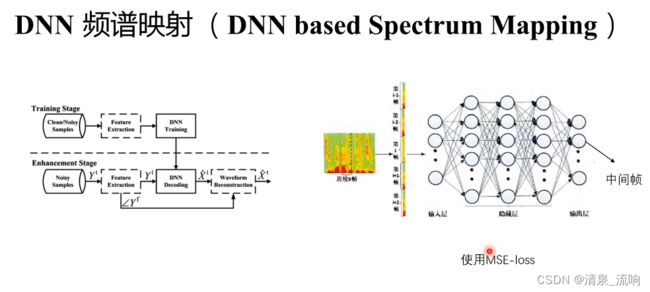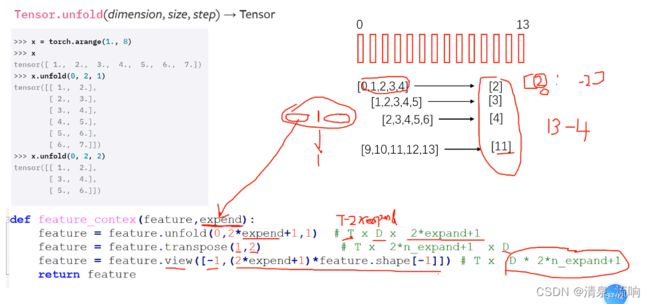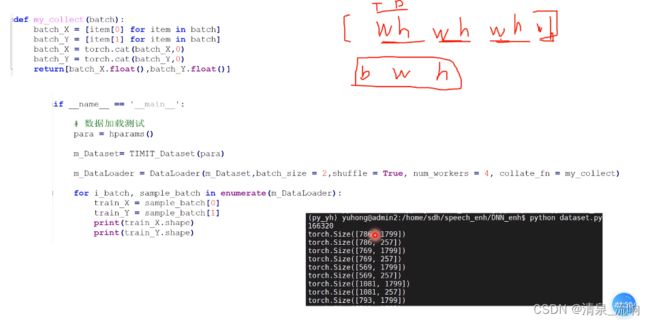语音增强——DNN(深度神经网络)频谱映射
内容来自B站视频:https://www.bilibili.com/video/BV1Vo4y1D7jJ/?spm_id_from=333.788&vd_source=77c874a500ef21df351103560dada737
输出层得到的是干净语音的频谱
get_scp.py程序如下:
import os
import numpy as np
base_path="TIMIT/TEST/"
with open("test.scp","wt",encoding='utf-8') as f:
# base_path="TIMIT/TRAIN/"
# with open("train.scp","wt",encoding='utf-8') as f:
for root,dirs,files in os.walk(base_path):
for file in files:
file_name = os.path.join(root,file)
if file_name.endswith(".WAV"):
print(file_name)
f.write("%s\n"%file_name)Psignal和Pnoise是能量,Asignal和Anoise是幅值
librosa读取数据会把语音归一化到[-1,1]之间,因此我们不用librosa,我们使用soundfile,直接读取原始数据
程序如下:
import os
import numpy as np
import random
import scipy.io.wavfile as wav
import librosa
import soundfile as sf
from numpy.linalg import norm
def signal_by_db(speech,noise,snr):
speech = speech.astype(np.int16)
noise = noise.astype(np.int16)
len_speech = speech.shape[0] # 得到语音的长度
len_noise = noise.shape[0] # 得到噪声的长度,噪声的长度要远大于语音的长度
start = random.randint(0,len_noise-len_speech) # 返回0~len_noise-len_speech之间的任意整数
end = start+len_speech
add_noise = noise[start:end] # 从噪声信号截取一段与语言信号长度一样的噪声段出来
add_noise = add_noise / norm(add_noise) * norm(speech) / (10.0 ** (0.05 * snr))
mix = speech + add_noise
return mix
if __name__=="__main__":
noise_path = "D:\\深度学习数据集\\NOISEX"
noises = ['babble', 'buccaneer1', 'destroyerengine', 'factory2', 'volvo', 'white']
clean_wavs = np.loadtxt('scp/train.scp', dtype='str').tolist()
clean_path = "D:\\TIMIT"
path_noisy = "D:\\深度学习数据集\\DNN-Mapping\\nosiy"
snrs = [-5, 0, 5, 10, 15, 20]
with open('scp/train_DNN_enh.scp', 'wt') as f:
for noise in noises:
print(noise)
noise_file = os.path.join(noise_path, noise + '.wav')
noise_data, fs = sf.read(noise_file, dtype='int16')
for clean_wav in clean_wavs:
clean_file = os.path.join(clean_path, clean_wav)
clean_data, fs = sf.read(clean_file, dtype='int16')
for snr in snrs:
noisy_file = os.path.join(path_noisy, noise, str(snr), clean_wav)
noisy_path, _ = os.path.split(noisy_file)
os.makedirs(noisy_path, exist_ok=True) # 文件路径不存在则创建路径
mix = signal_by_db(clean_data, noise_data, snr)
noisy_data = np.asarray(mix, dtype=np.int16)
sf.write(noisy_file, noisy_data, fs) # 把噪声数据写入该路径(noisy_file)下
f.write('%s %s \n' %(noisy_file, clean_file))
假设语音信号有14帧,用5帧预测一帧(中间帧),最终因此只能预测10帧【2~11】
expend=左边扩展帧=右边扩展帧=3,因此本程序用3+3+1=7帧预测一帧
tensor.unfold的dimension表示,沿着哪一个维度进行取帧的,本程序令dimension=0,表示沿着时间的维度取帧,size表示取几帧,step表示移动步长
为什么不直接把结果进行MSE,而要进行 BatchNorm1d后在MSE?
原因如下:若不进行BatchNorm1d,数值取值范围很大,用神经网络映射一个取值范围很大的数时,收敛很慢,所以为了提高收敛速度,必须加入BatchNorm1d
测试阶段:


















